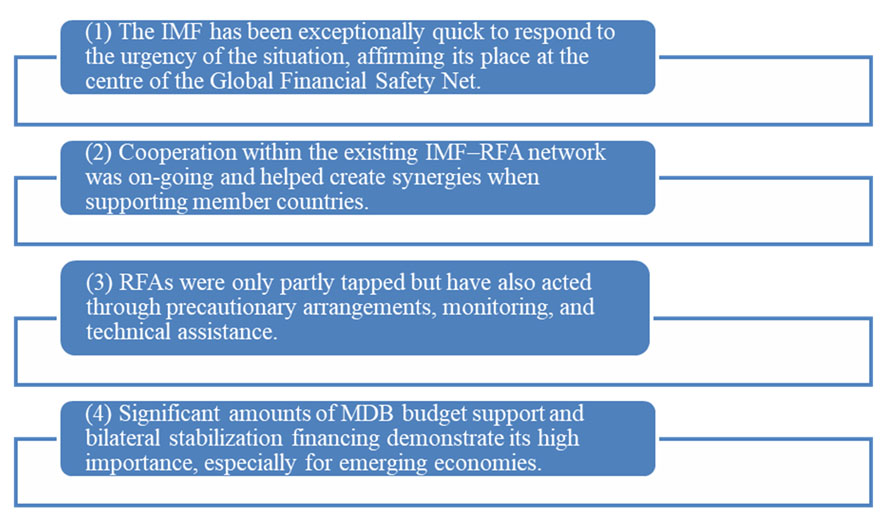A new EFSD Working Paper WP/21/1 “Evolution of Tools and Approaches within the Enlarged Global Financial Safety Net in Response to the COVID-19 Crisis” has been published. It continues the series of working papers on global financial safety net (GFSN) functioning. The report provides an answer to the questions on the volumes of financial support as well as new instruments and the modality of institutional coordination within GFSN.
In addition to the classic elements of the GFSN (international reserves, bilateral swap arrangements, EFSD, and IMF), the authors included in their analysis budget support provided by the multilateral development banks and the bilateral financial support as the two additional elements of the GFSN.
On the global level, the IMF implemented a comprehensive action package, affirming its place at the centre of the global financial safety net. Regional financing arrangements (RFAs) provided financial support and adapted their lending policies, toolboxes, and internal procedures to expedite the provision of emergency support to their members. From the currently existing RFAs, the Arab Monetary Fund and the EFSD provided $2 billion and $650 million of financial support to member countries, respectively, partly in combination with IMF programmes. In case of the European Stability Mechanism, large-scale precautionary arrangements in the amount of €240 billion contributed to instilling confidence, which helped stabilise financial markets and reduce risks to the financial stability of the Eurozone. Furthermore, multilateral development banks (MDBs) stepped up at the early stage of the pandemic and supported their states with significant volumes of emergency financing.
EFSD recipient countries have drawn on almost all layers of the GFSN, except bilateral swap arrangements, to mitigate the impact of the COVID-19 crisis. The funds disbursed from all sources in 2020 totalled at least $2.6 billion, from which $650 mln were approved by EFSD, almost 25% of the whole package. Their composition varies by country. Armenia received financing from the IMF. The Kyrgyz Republic had primarily bilateral financial assistance from Russia, the IMF, and MDBs for stabilization purposes. The IMF, EFSD, and MDBs were the three most significant sources for Tajikistan. In Belarus, Russian bilateral assistance and the EFSD were significant sources of stabilization financing. In Russia and Kazakhstan, MDBs were key international donors during COVID‑19 crisis, with support amounting to $2.75 billion.
From the institutional perspective, the IMF and EFSD play leading roles in the region as sources of stabilization financing. At the same time, in addition to the EFSD and the IMF, EFSD member countries actively used anti-crisis financing from MDBs and received a significant amount of bilateral support from Russia.
In the working paper, the authors identified four main features of GFSN response to the COVID-19 crisis.

Coupled with these structural features, the authors see new challenges to the GFSN functioning in the region and worldwide. First, as the global recovery progresses, the GFSN institutions are expected to gradually shift to supporting structural transformation of countries to the new post-pandemic circumstances, including restoring policy space, addressing large financing needs, and reducing debt vulnerabilities. Second, in the pandemic’s aftermath, many countries will have to deal with high public and private debt burden. Third, MDBs’ inclusion in the GFSN has several advantages and at the same time introduces new systemic risks that should be dealt with possibly at the level of G-20.
The full text of the Working Paper is available at the EFSD website. To access other EFSD publications, please use this link.